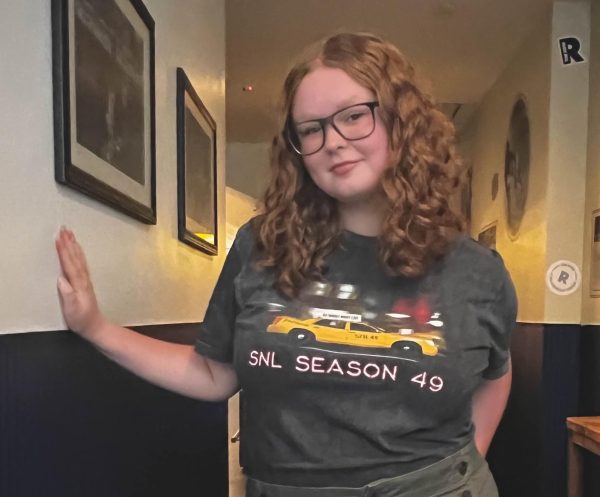Sexualization of food in advertising contributes to obesity epidemic
March 12, 2018
Seinfeld has been an integral part of society. From such ideas as “the regifter” to the celebration of Festivus, Seinfeld
has heavily impacted some of our societal norms. In the episode, The Blood, George Costanza, is talking to Jerry about his life and says, “Food and sex. Those are my two passions”. However, this quote also reveals how food is marketed.
Throughout society, food is an important part of life. Aside from needing it to sustain ourselves, we gather with family and friends for meals that allow us to connect with one another. However, food is also something that can be used against us. Advertising campaigns market food with the idea that people can eat as much of it as they want and not gain weight.
Many people, including myself, know this to be a lie.
Food can be twisted from what it really is to something that makes people want more and more. Some of the best examples can be found in the Jean Kilbourne book, Can’t Buy My Love.
Kilbourne delves into just how food is sold to people. One advertisement shows a woman eating Breyer’s Ice Cream with the tagline, “Your taste buds cry out yes, yes, oh yes”. This advertisement demonstrates the comparison between tasting food and having an orgasm. Although this is something many of us may feel when stressed out and we eat an Almond Joy, we don’t always scream for pleasure when eating, also because our mouths are full.
Going back to Seinfeld, the episode, The Mango, George’s latest girlfriend finishes eating risotto in a manner that seems like she has had what could be the best sex of her life. She lies back in the booth their sharing, pulls out a cigarette and lights it. While the pasta can be good, food has become sexualized
to appear even as a common form of communication, plenty of people have found that using the eggplant emoji can be quite titillating
Häagen -Dazs Ice Cream used a marketing campaign of people using the ice cream as a sex toy. Once this ad started running in the United Kingdom, Häagen-Dazs sales went up 300 percent. Food has become sexualized but has become normalized in our culture.
Another advertisement Kilbourne shows demonstrates just how sexual food can be by shaping it into a bra and panty set. This has only been popularized by the candy lingerie sold at the candy store, It’s Sugar, with them selling candy bra and panty sets. Seeing shapes of food life this has become normalized as people have gotten used to the sexual way a person can nibble at a strawberry or lick whipped cream off their finger.
Even online, food porn has become a huge hit. Whether it’s salivating over a burger that would kill you after one bite, or the way we feel starved after looking at a cake layered in rich, gooey chocolate. Many people are familiar with the banned Skittles ad of a married couple on their wedding night are having sex and the groom ejaculates Skittles onto the bride. I’m pretty sure if you’re tasting the rainbow that way, you should call a doctor.
Finally, comes the concept of making food something that is considered, “unholy”. In doing this people have begun to think of food as “sinfully delicious”. As if there is some unknown eleventh commandment saying that the pint of Ben and Jerry’s Cookie Dough ice cream in your refrigerator goes against whatever Supreme Being(s) a person believes in. She also shows an advertisement of a priest saying that something is “40 percent sin, 60 percent forgiveness”.
We are being told to be sorry of the fact that we eat food and that we should feel bad about having some kind of spread on toast. As someone who loves food and has mastered the “not so endearing art” of overeating, advertising has deceived people into thinking certain foods are good not for you but for who you can be.
Sugar is one additive that makes food addictive so that once people start eating something; they keep going back to it. The documentary, Sugar Coated, shows just how sugary foods have been marketed by the sugar industry as healthy. With over 56 different names for sugar, this has allowed the processed food industry to hide the unhealthy sugar in products. In the film, one man, who ate healthy foods and nothing processed was found to be a borderline diabetic.
In this documentary, people are shown just how the processed food and the sugar industries have been maintaining the idea that there is no link between sugar and certain diseases, like diabetes, heart disease, etc. This brings more and more sugar into our lives without even recognizing it.
Another factor of this documentary is that health organizations that people rely on for product information have violated public trust by endorsing products that are extremely unhealthy. The documentary uses two examples, with the first example being the Healthy Check program from the Canadian Heart and Stroke Association. During this program’s tenure, this seal was given to a product called FruitSource.
FruitSource was found to contain high amounts of sugar and isn’t necessarily something you would want to give to your kids, despite the types of cereal they are marketed everyday. The Healthy Check program was discontinued and thus people were left in limbo as to what is healthy once again. However, the second example of the film is when the FDA, Food and Drug Administration gave the sugar industry a safety approval.
While this sounds harmless, however, it should be noted that the head of the head of the FDA review board was George W. Irving Jr., a former scientific research director for the International Sugar Research Foundation. He didn’t recuse himself from the vote, which gave the sugar industry the public access they needed.
Much of this information sums up the umbrella concept that advertising uses, being, we live in a society that pushes gorging on sugar and over consumption of calories, but adversely promotes being thin and skinny as normal.
However, food can become addictive and unlike alcohol or cigarettes, we can’t quit food. Alcohol and cigarettes are products of consumerism, while food is a necessary means of survival. Despite serious consequences from overeating, stress binging, among others, we consume food almost at a rate in which we consume media/advertisements.
The consequences and uses of these kinds of ads have become a means for making us want more and more. However, as people gain weight and inevitable cause people to become obese.
Currently, America’s obesity rate is up to 38.2 percent, according to the OECD’s 2017 obesity update. Try as we might, people will never look like the people in these ads.
And it’s that glimmer of antagonistic hope that’s worth believing in.




